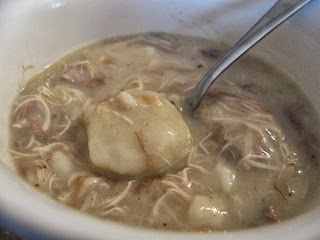If I could only grow one kind of fruit or berry, I think it would have to be blackberries. They grow wild in many parts of the country, but they are also incredibly easy to grow in your yard or garden. They pretty much take care of themselves. All we do is fertilize them with organic fertilizer in the spring, spread mulch around the canes, and keep the area weeded. That's it. Complex spraying regimes are unnecessary and our bushes have always been untroubled by insects or diseases.
 |
| 'Triple Crown' blackberries require a trellis while 'Chester' blackberries do not. |
You can find varieties of blackberries that will grow well in USDA hardiness zones 5-10. We live in zone 5, so we bought two varieties of thornless blackberries that can withstand cold temperatures. The 'Triple Crown' variety is my favorite. It does require a trellis to support its long, floppy canes. Those long canes, however, yield huge numbers of berries, up to
30 lb PER VINE.
 |
| A 'Triple Crown' berry cluster. |
After all the berries have been harvested for the year, you have to cut the spent canes back and tie up the new canes that grow to take their place. Simple.
 |
Blackberries! And a few raspberries. Raspberries are pretty easy to grow, too, but
they are not nearly as bountiful producers for us. |
Blackberries are also exceptionally nutritious. Each cup of berries contains 50% of your RDA of Vitamin C, plus large amounts of fiber and cancer-fighting antioxidants.
About the only drawback to blackberries is that the fruit is highly perishable. If you pick them when they are dead ripe on the vine, you really only have a few days to eat them before they are past their prime. They are easily preserved, however.
I can
blackberry jam and freeze many pints of whole berries to use in cobblers later in the year. You can also dehydrate the berries whole or try this recipe for blackberry leather (aka fruit roll-up). The leather will last up to a year when stored properly.
How to make Blackberry Fruit Leather:
There are only two ingredients in this recipe:
5 lb blackberries
1 lb applesauce. I used sweetened applesauce that I canned myself.
The first, and most difficult, task is to seed the blackberries. You can stew them and then press the softened berries through a fine-mesh sieve, but that will drive you bonkers and possibly stain your entire kitchen with blackberry juice. It is much easier to use a food mill of some kind.
 |
| My Roma Food Mill, ready for action. |
I use the berry screen attachment (sold separately) and it keeps every single one of those tiny blackberry seeds out of the juice. I usually pass the pulp through the mill three times just to make sure I get out all of the juice and then I feed the remaining pulp to my chickens.
 |
| The blackberry juice and applesauce mixture |
Stir in the applesauce and you are ready to make fruit leather. (The applesauce is used to improve the texture of the final product. You can't really taste it.)
I have an
Excalibur Dehydrator that I really like and recommend.

If you don't have a dehydrator, you can try making this in your oven, though I haven't tried it and can't vouch for it. You would want to keep your oven at the lowest possible setting, use parchment paper instead of plastic wrap, and check on it often.
Assuming you have a dehydrator (and if you are a gardener or prepper, you really should!), this is how to proceed:
Line the dehydrator trays with plastic wrap, taking special care to make sure the wrap is secure. I left an 1" margin on both sides of the tray so the air could circulate more easily.
 |
| Fruit on the prepared tray |
Spread the fruit mixture on the plastic wrap. You are looking for a depth of approximately 1/4", but you want the edges to be thicker than the center. That will help the whole sheet of fruit dry evenly.
 |
| Loading up |
This recipe filled 6 of the 9 trays of my Excalibur. I set the temperature at 135 degrees. After about 5 hours, I checked on the leather and it was making excellent progress. I turned it down 20 degrees, just to make sure that the leather remained pliable and did not get brittle. After a total of 15 hours, the leather was at the perfect consistency. It was tacky to the touch, but not wet. The time it takes your batch of leather to dry will be dependent on many factors - your dehydrator, the humidity, how thick you spread the fruit, etc.
 |
| Done! |
Then all you have to do it remove the plastic wrap from the tray and roll it up like a scroll.
I cut each roll in half so they would could fit in quart canning jars for storage.
Next, I used my
Food Saver's accessory attachment to vacuum seal a clean, used canning lid to the jar.
Et viola! A healthy, homemade snack that will last until next year's blackberry harvest. If I can keep it hidden from my kids, that is...















































